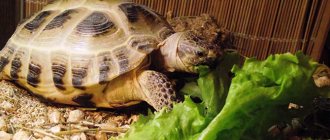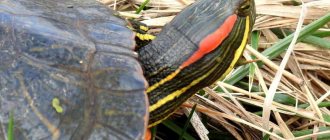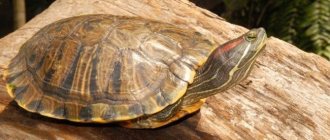People often want to have an exotic pet in their home, and many choose turtles. This reptile, being one of the most ancient animals on the planet, has mastered two habitats, and can be found both in water and on land.
Turtles are the oldest species of reptiles and live both on land and in water.
Natural habitat and lifestyle
The family of land turtles includes 16 genera and 57 species.
Habitat: Southern Europe, Central Asia, Kazakhstan, Africa, America, China. Some species inhabit savannas, steppes, deserts, and live in tropical rainforests.
Turtles in nature choose ready-made burrows for their homes; if there is no such housing, they dig them themselves. The soils where reptiles live can be loamy or sandy. Turtles like to settle in high places. For normal life, they need grass and proximity to a body of water.
Lifespan
Turtles are truly long-lived even by our human standards, because they live many times longer than us humans. So the average life expectancy of turtles in natural conditions can be 180-250 years.
The oldest turtle in the world, named Jonathan, lives on the island of St. Helena and remembers (probably) the times of Napoleon, because the former emperor of France lived here in exile for some time.
Features of land turtles and appearance
To understand how to distinguish a land turtle from an aquatic one,
it is necessary to consider the characteristics of land inhabitants:
- The size of individuals varies from 10 to 180 cm. The largest land tortoise is the elephant (or Galapagos) tortoise, more than 1.8 m long.
- The shell of reptiles can be of 2 types: flattened or high. From above, the back of the animal is covered with a strong carapace, the abdomen is hidden in a plastron.
- The shell is so strong that it can support a weight many times greater than the mass of the turtle itself.
- The elephant-like, powerful and short legs have fused toes with free claws.
- The short triangular tail ends in a sharp spike.
- The coloring of turtles does not attract attention. Most often, individuals are brown, olive-gray, or yellowish.
- Leathery scutes and scales cover the tail, head and legs.
- Some species hiss like snakes when threatened.
- If a turtle needs to protect itself, it quickly empties its bladder.
- A leisurely animal does not run away when in danger, but pulls its body inside its shell.
- Females are larger than males.
Land turtles, unlike aquatic ones, have a less bright body color, are more expensive, but are cheaper to maintain, they are easier to care for and clean the terrarium.
The shape and type of shell is associated with the lifestyle of turtles
Look what the largest land turtle looks like???
How to determine gender
The gender difference in turtles is so weakly expressed in appearance that it is sometimes difficult to determine whether this turtle is a “boy” or a “girl.” However, if you approach this issue with due attention, you can identify a number of signs that help determine the sex of a turtle.
1. Shell; in females the shell has a more elongated shape than in males.
2. Plastron, also known as the lower part of the shell. If you turn the turtle over, you can see that in females the lower part of the shell (the one closest to the anus) is flat, while in males it is slightly concave.
3. Tail, males have a tail that is longer and wider at the base, while “lady turtles” have a straight and short tail.
4. Claws, in males they are usually longer on the forelimbs than in females.
Types of land turtles
Among the huge variety of land turtle species, not all can be kept at home. All babies are born small - the body does not exceed 3 cm. During its life, such a turtle can gain weight up to 900 kg.
Individuals whose body size does not exceed 30 cm in length are suitable for home breeding.
Steppe Central Asian
The Central Asian turtle has been bred at home for more than 50 years. By the age of 10, the reptile reaches sexual age, and grows in length up to 30 years. Inhabits the territories of Central Asia, Afghanistan, Iran. Yellowish or brown carapace, slightly convex. The plastron consists of 16 scutes; the carapace includes 25 links in the side part and 13 in the top.
Central Asian tortoise
Mediterranean
Popularly it received other names: Caucasian or Greek. The color of the carapace can be of three colors: yellow, olive, brown. It grows no more than 35 cm in length. The scutes may contain black inclusions. Under natural conditions, it inhabits North Africa, Dagestan, Armenia, Georgia, the Caucasus, and Greece. Good for home keeping.
Mediterranean turtle
Kinixa
Toothed Kinix is the name of Schweger's land turtle. Listed in the Red Book. The carapace is elongated and flattened. Yellow stripes are clearly visible on a brown background. Plastron yellow. Distribution range of the fringed land turtle –
the island of Sardinia and southern Greece.
Jagged Kinix
Star-shaped
This species can be found in India, Sri Lanka, and Pakistan. The dimensions of the shell of a large land turtle are as follows: male - 15 cm, female - 25 cm. The color of the carapace immediately catches the eye - each scute is bordered by a yellow convex pattern in the shape of a star. The star-shaped variety is a decoration for a terrarium. At home it can live up to 80 years.
Stellar turtle
Radiant
Rare species, distribution area - Madagascar Islands. The turtle got its name due to the fact that it has regular yellow lines on its shell, similar to the rays of the sun.
Unlike red-eared turtles, land turtles do not need water - they live on land. They only need liquid for drinking.
Radiant turtle
Chinese trionix or Far Eastern turtle (Pelodiscus sinensis)
This turtle has a greenish-brown shell with a glossy surface. It reaches 25-30 cm in height, covered on top with soft skin without horny scutes. In young individuals, the “back” is covered with tubercles, which gradually disappear with age, and the shell takes on an almost flat appearance. Trionix's neck is very mobile and long, and its muzzle is elongated into a proboscis, at the end of which there are clearly visible nostrils. The powerful jaws of this predator have sharp cutting edges, which can cause serious injuries to the turtle, which makes it quite dangerous. Wounds after such “bites” do not heal well, so you need to be very careful when handling this pet. In addition, there are sharp claws on three toes, which also pose a threat. An unusual feature of Trionix is additional skin respiration, along with pulmonary respiration.
According to amateurs, Chinese Trionix is a very suitable candidate for keeping in a terrarium, since the ratio of water to land should be 5:1, and it is very convenient to observe the behavior of the turtle. However, it must be kept separately, since Trionix can pose a threat not only to its owners, but also to other soft-shelled turtles.
Pros and cons of home keeping
There are positive and negative aspects to keeping land turtles. Let's start with the advantages:
- unpretentious pets do not require close attention, therefore they are recommended for people with an unpredictable regime;
- for land turtles at home it is easy to recreate conditions close to natural;
- when going on vacation or a long trip, you can take the animal with you in a carrier or in a box;
- you can ask your neighbors to look after the turtle while the owners are away;
- feed is cheap;
- animals are not aggressive;
- clean;
- hypoallergenic;
- do not require constant walking;
- feeding frequency is convenient for owners;
- does not cause damage to the apartment.
In addition, pets can live perfectly alone; they do not need to buy a companion. However, there are also negative aspects when maintaining a house:
- many land turtles are endangered species and are listed in the Red Book, so they cannot be kept at home without the appropriate documents;
- since the pet does not control natural processes, the animal cannot be trained to use a tray;
- the terrarium needs to be cleaned frequently, the whole procedure takes at least an hour;
- after walks, excrement remains on the sofa;
- may bite if hungry or feels discomfort;
- the shell can become a breeding ground for fungal microorganisms, so you must wash your hands after contact with the turtle.
It is not of particular interest to children, as it does not support active games. Some species have a completely restless character.
Watching a turtle can bring a lot of joy
Keeping a land turtle at home
The land turtle requires minimal care. Once every 7 days she should be bathed in warm water, the temperature of which does not exceed +30°C. You should not pour a lot of water into the basin; the level should be equal to half the shell. When animals begin to shed, it is recommended to add 1 tsp during washing. soda Long claws are shortened with a manicure file.
Rule 1. Spacious terrarium
After purchase, the land turtle must be placed in a box - a temporary home until the terrarium is ready. You cannot leave your pet on the floor, as temperature changes are contraindicated for him. It is better if a 100 liter tank is chosen for the turtle. Ideally, the parameters of the terrarium should exceed the length of the animal by 3 times. You definitely need a house in the container so that the reptile can rest peacefully from the gaze of household members.
Rule 2. Soil without small particles
The bottom of the terrarium must be lined with soil 10 cm thick. Medium-sized pebbles can be used as a covering, since the turtle can swallow small pebbles. Some people use scented sawdust. However, this coating has one drawback - they quickly become dirty.
The most ideal option would be a mixture of hay and pebbles. You should not put cat litter, sand, or garden soil on the bottom of the terrarium. The fact is that a turtle can eat such soil, which will lead to deterioration in health.
Caring for a land turtle at home begins with arranging the home
Rule 3. House for privacy
Inside the main tank you need to install a house (possibly wooden). It is necessary so that the turtle can hide from the rays of the sun and have privacy.
Rule 4. Edible plants
You can decorate the terrarium with potted indoor flowers: climbing plants, aloe, sansevieria. It is best to transplant the flowers into a small pot and place them in a tank. The soil in the container must be covered with stones. You should not decorate with poisonous plants, as the turtle may taste the leaf.
To decorate your terrarium, choose non-hazardous plants.
Rule 5. Temperature as in nature
In the terrarium, it is desirable to create the same living conditions for turtles as they are accustomed to in the wild. Since reptiles are heat-loving animals, the air temperature should not fall below +25°C.
Rule 6. Heating as part of the temperature regime
You can maintain optimal mode using a 75 W incandescent lamp. It should be placed at a height of 40 cm from the bottom of the terrarium.
Rule 7: Lighting to supply vitamin D
In addition to the incandescent lamp, it is necessary to install an ultraviolet lamp at the same level. It will supply your pet with vitamin D3, which is necessary for the absorption of calcium.
The desired temperature in the terrarium is achieved using a heating lamp
Rule 8. Proper feeding
To keep the turtle healthy, feeding should be done at the same time, preferably in the morning. After a while, the pet will get used to this regime and will expect the next treat. Turtle breeders recommend following the following rules when feeding:
- Babies need to be fed daily, adults – once every 2 days.
- The food container must always be clean.
- Feed small amounts, although the turtle will not eat more than it should.
- After finishing the meal, the saucer with the remaining food must be removed from the tank.
- Strong irritating noise and strong odors negatively affect the functioning of the digestive system.
- You cannot feed the animal by hand.
It is recommended to exclude harmful foods from your pet’s diet:
- garlic;
- insects;
- milk;
- spinach leaves;
- spicy herbs;
- food from the table;
- leaves of poisonous plants.
Attention!
The turtle should not be fed in the evening, as at this time the pet is preparing for bed. She will not be able to digest food, since her activity is zero. You can feed in the morning or afternoon, at this time the digestive tract works well. No leftover food should be left behind.
The basis of the diet of a land turtle is plant food.
If a turtle tramples on its food, it considers it no longer edible - spoiled. A pet may refuse a favorite treat for several reasons:
- overfeeding;
- no fasting days;
- abuse of treats.
Taking into account the size of the reptile, it is necessary to calculate a single portion. The amount of food per day should be equal to half the length of the shell, and a piece of food equal to half the turtle’s head.
Do not feed foods that have undergone heat treatment. All food should be raw but warm. The diet should not be the same. Only variety will allow the reptile to get all the nutrients.
Turtles love bright colors. To ensure that food is completely absorbed, it is recommended to give yellow, red, orange foods.
Feeding for land turtles should vary depending on the season. In summer, you should include more plant food in your diet. Turtles need to be fed:
- dandelion leaves;
- cucumbers;
- clover;
- berries;
- pumpkin;
- zucchini;
- mushrooms;
- sorrel.
In winter, common vegetables are: beets, cabbage, carrots. Fruits are necessary for reptiles to saturate the body with vitamins.
From time to time, crushed shells should be on the menu. Bone meal can be given to meet calcium requirements. Juicy greens saturate the body with moisture, which prevents dehydration.
Diet diversity improves health and increases life expectancy
Rule 9. Vitamins for prevention
To strengthen the shell, it is necessary to give calcium powder. Alfalfa meal will provide your pet with additional beneficial substances.
Pharmacy vitamins can only be purchased after consultation with a veterinarian. Medicines for humans are not suitable for treating turtles - they are toxic to pets.
Rule 10. Be sure to drink if the food is not juicy enough
If land turtles have enough succulent food, they do not need additional liquid. Therefore, the diet should include vegetables: cabbage, cucumbers, greens, lettuce. The products not only saturate the animal, but also satisfy its need for fluid. In summer, you should include clover and dandelions in your diet.
Reptiles especially need to drink when dehydrated, which occurs as a result of insufficient feeding of juicy vegetables. You can install a saucer or drinking bowl at the bottom of the terrarium. The water should always be warm, so the saucer should be placed under the lamp. The reptile often turns over the drinking bowl, so you need to constantly update its contents.
Attention!
Turtles often like to defecate in the water. Therefore, the owner must constantly monitor the cleanliness of the liquid. If your pet drinks contaminated water, it can become seriously ill.
A complex of vitamins and minerals can be purchased at pet stores
Rule 11. Mandatory walks
Walking down the street with a turtle is allowed if the air temperature remains at +25°C for several days. If the reptile gets hot, it will try to hide in the shade. To prevent your pet from getting lost or being attacked by dogs and children, you need to constantly monitor the tiny creature.
A turtle can walk on the sofa in the house, but not on the floor.
Rule 12. Regular bathing and hygiene
Many people do not know how to properly bathe a land turtle, so they are afraid to carry out this procedure. There is nothing new about how to wash your pet. Bathing should take place every week. Warm water should be poured into the basin in such a volume that it covers the turtle’s shell just above half. The water temperature for swimming should be +25°C.
Walking in the summer is a must
Wintering and hibernation
Turtles usually spend 8-10 weeks (babies) and 12-14 weeks (adults) in hibernation. If you put it to sleep artificially, you need to calculate the time to wake the turtle from hibernation in February. At this time, the length of daylight hours increases.
The condition of reptiles should be checked every month. It is acceptable if the weight of individuals decreases by 1%. If turtles lose weight quickly, it means they are sick and hibernation must be stopped. You cannot swim during winter.
How to properly put a turtle to sleep:
- You need to make sure that the reptile is healthy. It is not recommended to give vitamins before wintering.
- Immediately before hibernation, it is important to fatten the pet so that it has enough fat reserves for the wintering period. The pet needs to drink.
- The turtle should be bought in warm water, wiped dry and not fed for 1 week (kids), 2-3 weeks (adults). This time is necessary so that all the food eaten by the reptile can be digested.
- Now you need to gradually reduce the temperature and daylight hours.
- For wintering, you need to prepare a special tray, on the bottom of which lay wet sand, peat, and place sphagnum moss. The thickness of the layer should be 20-30 cm. The turtle is placed on this layer and covered with hay or dry leaves. The substrate should be moist, but not wet.
- In this form, the container with holes made in it should spend 2 days at room temperature, then it should be moved to the corridor and placed on the tile.
- You need to know how to wake up a turtle in order to bring it out of hibernation without harming it. All manipulations must be carried out in reverse order. A warm bath will help bring your pet out of his stupor.
If everything is fine with the turtle, it will begin to eat after 5 days, once the optimal temperature has been established.
Preparing for hibernation, the turtle tries to burrow into the ground
Origin of the name
If we consider the Slavic and Latin origins of the name of the reptile, it is easy to see the commonality. Both languages demonstrate a response to appearance in the word: translated from Latin “tile”, “clay vessel”, “brick”; from Slavic - “shard”.
Indeed, many turtles resemble the stone for which the people who gave them this name mistook them. Despite this etymology of the name, it also contains an indication of the unique shape and color of the hard shells.
Compatibility
Turtles do not need neighbors, they do not suffer from loneliness. If you really want to get yourself several turtles, then Mediterranean and Central Asian turtles support cohabitation. Forest, steppe and desert will be at enmity. Representatives of other species should not be placed with pets, as they can be carriers of various diseases.
Frogs, snakes, toads, crocodiles, lizards, snails, and newts should not be kept together with reptiles. Turtles are not compatible with chameleons and mollusks. The fact is that all animals have different requirements for humidity and temperature. Each species requires a specific type of terrarium and soil.
Nutrition
The diet of turtles directly depends on their species, habitat and lifestyle. Land turtles are practically vegetarians; their main food is tree branches, fruits and grass, mushrooms and vegetables. However, it was not in vain that we wrote practically, since in order to maintain the protein balance in their bodies, turtles can sometimes eat various small animals such as snails, slugs and worms. Land turtles also drink water with pleasure.
But sea and freshwater turtles are already real predators, since their diet includes various small fish,
frogs, snails, crustaceans (some sea turtles happily eat squid, cuttlefish and other shrimp). But the gastronomic preferences of aquatic turtles are not limited to living creatures; along with them, they also eat plant foods: algae.
Interesting fact, there are species of sea turtles that eat poisonous jellyfish. From such food, the meat of the turtles themselves, in turn, becomes poisonous, which scares potential predators away from them. This is a gastronomic remedy.
Reproduction of land turtles
Turtles become sexually mature at 6 years of age. Before mating, it is recommended to make sure that the pets are not sick. The main conditions for good development: hibernation, balanced nutrition, warmth.
Females should be larger than males. Boys need to be placed next to girls, not the other way around. There may be more females. It’s good if the gentlemen start fighting for the right to please the ladies. However, everything that happens must be monitored so that the males do not injure each other.
Once pregnant, the turtle becomes restless, loses its appetite, and begins to fence off space. A pregnant female should be fed different types of food so that she can make a choice. You should definitely add calcium to your food.
Attention!
Pregnancy lasts 60 days; this period can be artificially extended if the female has not had time to prepare a place for laying.
How to determine the sex of a land turtle
How to find out the gender of land turtles? Females and males have visible differences. Females are significantly larger in size than males. When the males turn over, you can see a small depression on the shell - a concavity in the shell, which is what is necessary for mating. The tail of females is large, thick, and the cloaca is located at the base of the tail.
Caring for the Cubs
After the babies hatch, they can still remain in the egg for 3 days. They are born 3 cm long. If the turtles cannot get out after 3 days due to lack of strength, the owner must intervene and get the babies. If you are lucky enough to have twins born, you must be extremely careful with them, since the cubs are weaker than usual. Next, they should tie the umbilical cord with a thread, they will do the rest themselves.
Babies are kept separately! Housing conditions are similar to adult animals, only they should be fed soft food and irradiated with a 10% UVB lamp. Under good conditions, a turtle will live with its owner for at least 40 years.
Gender determination is possible from the age of 1.5-2 years
The largest lizard in the world is the Komodo dragon.
Of the existing representatives of lizards, the largest is the Komodo monitor lizard (giant Indonesian monitor lizard, Komodos monitor). Some specimens are striking in their size, reaching almost three meters in length and weighing 80-85 kg at maturity. By the way, the Guinness Book of Records includes a “dragon” from Komodo Island, which weighed 91.7 kg. These giants eagerly eat small animals - turtles, lizards, snakes, rodents, and do not disdain impressively sized prey. The Komodo dragon often feeds on wild boars, wild goats, cattle, deer or horses.
Diseases and prevention
Land turtles are in good health and rarely get sick. Diseases can result from improper maintenance or irrational feeding. Common diseases of turtles include: rickets, eye diseases, acute respiratory infections, pneumonia, helminthiasis, intestinal obstruction.
Rickets
The disease is accompanied by a lack of vitamin D3; rickets usually affects turtles that lack ultraviolet radiation. The development of the disease is accompanied by softening and deformation of the shell and plastron.
If rickets is noticed at an early stage of the disease, it can still be managed. To do this, you will need to adjust the power supply and install an ultraviolet lamp.
If the form is advanced, it is advisable to contact a veterinarian for a course of treatment with calcium injections. If rickets stops developing, the deformed shell will remain that way.
It is easier to prevent a disease than to treat it. You should take your pet for a walk in the fresh air so that he can soak up the sun’s rays a little. You also need to review your diet so that it contains enough vitamins and calcium.
Helminthiasis
If your pet is noticed to have frequent stomach upsets, when constipation alternates with diarrhea, and white dots that move are visible in the excrement, then the turtle has become infected with parasites.
Helminths enter the reptile's body with poor-quality food. Parasites can be found in terrarium fillers.
The veterinarian will prescribe the appropriate treatment. For preventive purposes, you can give the anthelmintic Albendazole once every 3 months. Deworming gives a positive result.
acute respiratory infections, pneumonia
If the turtles' mucous membranes become pale, it means the pets have a cold. After some time, breathing becomes difficult, a runny nose appears, everything inside wheezes, drooling with white foam.
Pneumonia rarely occurs in land turtles, but is more common in aquatic species. If you have a cold, your doctor should prescribe therapy with antibacterial drugs. The disease goes away after injections with antibiotics.
Pet turtles are easily susceptible to various diseases
Intestinal obstruction
The problem occurs in those pets who love to eat something inedible, for example, plastic, a piece of gum.
The main symptom of intestinal obstruction is irregular bowel movements. To eliminate the problem, you should try baths (solar and water). If warmth fails to return the turtle to normal life, you need to give an enema with chamomile decoction.
Eye diseases
If your tortoise's eyes become watery and swollen,
If the eyelids close and are difficult to open, then there is not enough vitamin A in the diet. To correct the situation, you need to wash the reptile’s eyes several times a day with a cotton swab dipped in a warm decoction of chamomile.
Your veterinarian may prescribe eye drops: Albucid and vitamin complex injections. It is necessary to reconsider your diet.
Infection with external parasites
Turtles can also get lice or fleas. They become noticeable if you look closely at the turtle's body. If present, you may notice small moving dots.
The treatment is as follows: the reptile’s skin is lubricated with a 5% Karbofos solution. After a few minutes, the applied solution should be washed off with a 0.2% Neguvon solution.
Attention!
Fungal diseases may also appear in the land turtle
.
The fungus appears on the shell.
You can avoid many diseases if you properly care for your pet.
Recommendations for selection and purchase
When buying turtles, you need to be aware that you are buying a pet not for a year, or two, but for a lifetime. After all, if good conditions are created, reptiles will live more than 40 years.
To get a turtle, you will initially need to invest a lot of money on the purchase of a terrarium, equipment, an ultraviolet lamp and a heating lamp, soil and special food.
You also need to know that the reptile is a non-contact animal, that is, it will never become attached to its owner. Therefore, they will not be fun to play with or interact with like other mammals.
Before purchasing you need to take care of:
- Reading the necessary information. You need to find out where and how animals live, what is needed for comfortable keeping. If you do not study the information, this can negatively affect the life of your pet, because it requires special treatment.
- Financial well-being, since you will need to constantly spend money on purchasing the necessary equipment and feed.
- Sufficient space. It is advisable to initially choose a house taking into account the fact that the pet will grow up.
- Free time. Caring for a reptile takes a lot of time, as you will often have to remove the terrarium, clean it, feed the pet, and possibly treat it.
Sometimes turtles appear in the house even before the owners become familiar with the information about their contents. This is wrong, because even before purchasing, you need to decide whether it will be possible to carry out proper care so as not to kill the animal.
Think carefully about the purchase, because the pet lives long enough
How to determine the age of a turtle
It is impossible to know exactly the age of a reptile if it did not come into the house immediately after birth. You can only roughly determine it. To understand how old an animal is, you need to:
- Pay attention to the size of the shell, its length.
- Count the rings on the carapace. In 1 year, approximately 2-3 rings form on the shell. To make an accurate determination, you need to count the scales and then find the average number.
However, it is worth considering that the rings, their size and number, depend on many conditions, for example, whether the turtle hibernated and in what conditions it grew. Rings on the shell appear up to a year. In older turtles, the carapace becomes smooth and the annual rings become pale.
In 1 year, 2-3 rings form on the shell
Prices for turtles
The cost of different types of land turtles in online stores and in pet stores starts from 20,000 rubles.
Silt (tadheaded)
A small but very unusual turtle. The disproportionately large head and paws, combined with a small oval-shaped shell, make it look like a dwarf among the turtle people. The length is rarely more than 18 cm.
It has false teeth that can penetrate deeply when biting and cause serious damage. Therefore, it is better to admire mud turtles from a safe distance and not touch them unless necessary.
They are not as demanding on the volume of the aquarium as other types of turtles: 60-100 liters are enough for loggerhead reptiles.
It feeds mainly on raw food of animal origin. Can be fed with dry food.
Interesting facts about land turtles
Land turtles appeared on planet Earth a long time ago and are one of the most ancient inhabitants.
The sex of turtles can be predicted. It depends on the conditions in which the eggs were located. Males are born if the eggs develop at low temperatures, females - at high temperatures.
In one museum in Ukraine, turtle eggs lay on display shelves for a long time. They were used as exhibits. But one day they burst and turtles were born.
Turtles are not considered aggressive towards humans. Only caiman species during the mating season can mistake a person for a rival and attack him.
Since ancient times, turtle meat has been revered as an exquisite delicacy. It can be consumed raw or after heat treatment. Turtle shells make beautiful jewelry and tableware.
Males during the mating season may mistake a person for a rival
Natural enemies
In the natural environment, turtles have many enemies, even though the animals have reliable protection - a shell. Reptiles are hunted by eagles, hawks and other birds of prey. To defeat the reptile, predators drop stones from a height and peck out its entrails.
Crows and jackdaws pose a danger to children. They completely swallow baby turtles that have just hatched from their eggs. Even foxes throw reptiles off cliffs to split the carapace and eat the animals.
Jaguars are the enemies of turtles in South America. Rodents bite off their tail and paws.
Note!
Sick turtles move so slowly that the soft parts are eaten by ants. Only Galapagos tortoises have no enemies. This is the only species distinguished by its impressive size and weight.
Population and species status
There are 228 species of turtles under protection. Of these, 135 species are on the verge of extinction.
Among land turtles, the least common species is the Central Asian land turtle.
Reasons that influence population decline:
- illegal fishing;
- unsustainable agricultural activities;
- construction of facilities.
In addition to the above factors, land turtles are caught by poachers for the purpose of sale for reproduction and breeding at home, sometimes not suitable for a particular species.
Turtle meat is a valuable delicacy. The unpretentiousness of reptiles has contributed to the fact that they are transported over long distances. The shell is used to make hair ornaments and use them for souvenirs.
The most famous rare endangered species is the Central Asian land turtle
Conservation of land turtles
Different countries are using all sorts of methods to try to combat the extinction of many species of land turtles.
- Rare species are prohibited for export, strict bans are imposed on turtle hunting, and trade in reptile meat, shells and eggs is prohibited. Authorities regularly raid markets and airports to prevent unauthorized exports and sales of prohibited items.
- Carrying out events whose purpose is to appeal to sanity and awareness of consumers. For example, in Mexico, for more than 20 years, authorities have been urging people not to buy trinkets and jewelry, and not to order turtle meat dishes in restaurants. Many species have been protected for many years, but more recently, the laws of many countries have included articles providing for criminal penalties for trade in turtles.
- There is a fight against the cultivation of turtles on special farms where they are bred and raised for meat. The animals are kept in terrible conditions. Many individuals are sick.
A website was created on the Internet that advocated a complete ban on turtle farms. To restore the population of endangered animals, people must come together and work together to restore it.
Reviews
The land turtle is an ideal pet to keep at home. Before buying a reptile, it is important to study information about the conditions of keeping and feeding the animal, as well as about creating comfortable conditions for its living. We must not forget that individuals hibernate. In order for the turtle to survive the wintering period well, it is necessary to prepare it for this moment, and then smoothly remove it from the state of sleep.
Would you like to purchase a land turtle for your own terrarium? Share in the comments!
What do lizards eat in the wild?
Basically, the lizard is a predator; it goes hunting early in the morning or at sunset. The main food of lizards is invertebrates: various insects (butterflies, grasshoppers, locusts, slugs, snails), as well as arachnids, worms and mollusks.
Large predators, such as monitor lizards, hunt small animals - frogs, snakes, and their own kind, and also happily eat the eggs of birds and reptiles. The Komodo dragon, the largest lizard in the world, attacks wild boar and even buffalo and deer. The moloch lizard feeds exclusively on ants, while the pink-tongued skink eats only terrestrial mollusks. Some large iguanas and skink lizards are almost entirely vegetarian, their menu consisting of ripe fruits, leaves, flowers and pollen. Lizards in nature are extremely careful and agile; they approach their intended prey furtively, and then attack with a swift dash and capture the prey in their mouths.











